
At the time of writing this article, the arduous task of budgets is in full swing. There has never been a time in my working career when the budget season has been so challenging and changing. Rising input and labor costs change on a day-by-day basis, it seems. Navigating and planning for the years’ expenses really requires those preparing their departments to drill down and assess those expenses. Where can we save? What can we prepay? Where are fuel prices headed? What do we need to do to stay competitive in the labor market to hire and retain?
And then there is policy. What will direct us through the coming year, and how do I rally staff to dive in? That adage “nothing is constant but change” rings through my head as new policies and mandates loom. Policy is our guiding principle as an organization. It’s what we believe is best for our employees and our business. Down streaming the communication of “the why” for policy change has never been more important. It affects peoples’ lives, their vacations, their vaccination status, and their livelihood. Assessing these policies prior to implementation has never been more important. They are not written in stone and can be rolled back or changed, but doing so after the fact could have lasting implications and impacts. Policy is not a bad word but making sure we have the right policy in place needs to come from groupthink, top-down buy-in, and formal execution of the practice or procedure.
Unprecedented staffing and labor shortages, the “great resignation” as it’s been termed, has really impacted our industry as well as many others. As Lyndsi Oestmann wrote in this column in January, this is the time we assess our bench players and our coaches. Do we have the right players in the right positions going into the year? Historically, any merit or across-the-board compensation increases come at the beginning of the first quarter. If there was a time for movement, promotion, reclassifications, or internal postings, now is the time. What do we need going into the year, and where are our gaps? It is imperative to assess how we fill those gaps and secure a strong enough bench. Sometimes major gaps can be filled by simple conversations and planting of the seed or bringing the possibility to an employee for advancement. Assess now in order to avoid rash panicked decisions later at planting, harvest, or whatever task needs to be filled by future leaders of your company.
One of the biggest assessments we make in a year is what is going into the planting plan. What is going into the soil in 2022, and what will sell in 2024 and beyond. Assessing market analysis and historical bell curves has shown us that our demands are always changing. Throw in inflation, rising costs referenced above, and a changing purchasing process will impact our industry. If we do nothing, we are not doing our job. Assessing increases and decreases in production models has never been more important as every labor and employee hour is borderline critical. We have to know what will sell, and the days of blind luck fliers or unfamiliar variety purchases need to be securitized for sales potential. Sometimes large swings are warranted, but mostly moderate “taps” here and there guide us and hedge us to that ultimate goal set or maximum return on investments. Sold out or sold through are not bad terms. Proper assessment will be the vessel that gets us there and ultimately make our year-end books shine.
Lastly, one of my personal assessment goals for 2022 is community outreach. Let’s not sugarcoat it. We need new blood and young people entering our industry. Succession plans are not going to get us there. As industry analysis shows us, we are failing in bringing new horticulturalists, growers, and IGC owners into this business. What can I do to reach out to our young people and show them the fun energy that comes with propagating, growing, selling, and shipping plants? Oregon’s historic number one commodity crop year after year is greenhouse and nursery. If you want to be in Ag, if you want to better the environment, if you want to have a sustaining, long-lasting career, horticulture can be where it is found. We need to step back and assess how to get our message out to this new up-and-coming “snap face gram” generation. If we fail to do so, if I fail to do so, then I didn’t assess.


Explore the February 2022 Issue
Check out more from this issue and find your next story to read.
Latest from Nursery Management
- Pennsylvania Horticultural Society announces 2025 Gold Medal Plant winners
- Leading Women of Horticulture: Angela Labrum, Bailey Nurseries
- The HC Companies, Classic Home & Garden merge as Growscape
- Terra Nova releases new echinacea variety, 'Fringe Festival'
- Eason Horticultural Resources will now officially be known as EHR
- BioWorks receives EPA approval for new biological insecticide for thrips, aphids, whiteflies
- Ellen Mackenbach-Lakeman appointed new CEO of Dümmen Orange
- The Growth Industry Episode 3: Across the Pond with Neville Stein





